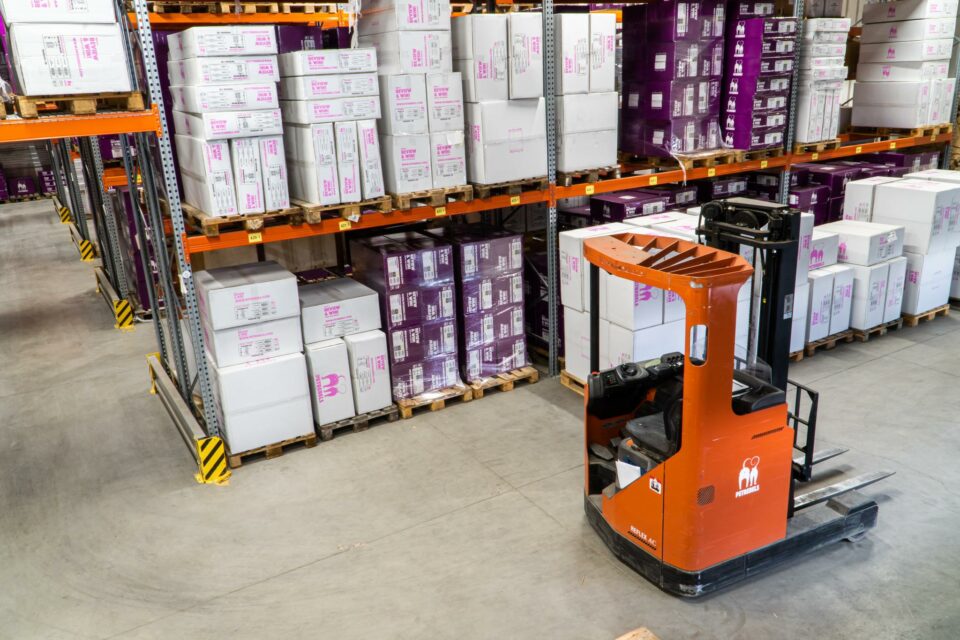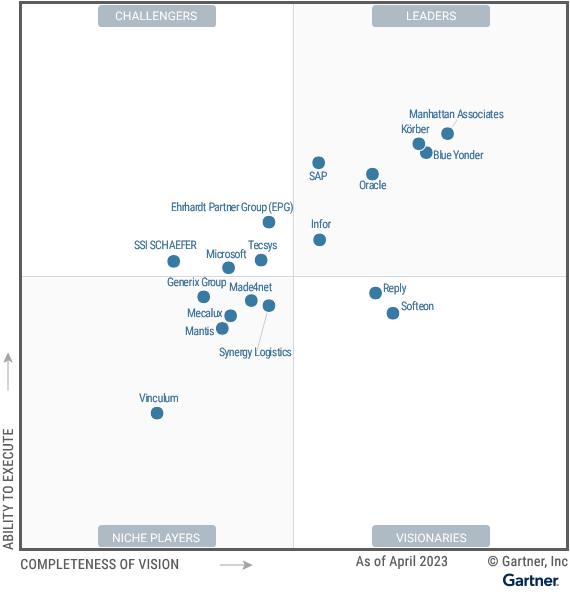
E-Invoicing and Its Geopolitical Stakes
France’s electronic invoicing reform relies on a Y-architecture, where Partner Dematerialization Providers (PDPs) play a central role in issuing and…
Generix Announces the Appointment of Olivier Vaillancourt as General Manager for North America View the press release

The first thing to understand about the report is the two criteria that fundamentally structure its evaluation of WMS vendors and service providers: Completeness of Vision and the Ability to Execute.
“Completeness of Vision” evaluates a vendor on the below criteria:
1. Market Understanding: Although the WMS market is mature, we see an accelerated need for innovation in areas such as user experience, adaptability, decision support, material handling automation and robotics integration, and work planning and optimization.
2. Marketing Strategy and Sales Strategy: Until recently, marketing strategy and sales strategy have had modest impacts on the WMS market, which has historically been dominated by specialist vendors focused on warehousing and logistics.
3. Offering (Product) Strategy: Offering (product) strategy is critical and has a high weighting. It refers to a WMS provider’s approach to product marketing, R&D, and solution delivery that emphasizes differentiation.
The criteria used for evaluating a vendor’s Ability to Execute include:
Of course, the report also looks into the actual products being marketed, the Warehouse Management Systems themselves. On top of the core and extended WMS capabilities, the Gartner® report considers a number of WMS features.
It looks, for instance, at the strengths and cautions of a WMS’s technical architecture, and how those affect its integration capabilities. The evaluation also accounts for how a WMS is able to support cross-functional process orchestration.
Time to market, time to value, and the quality of technical support are important to WMS buyers, as those can have a significant impact on ROI. We feel the Magic Quadrant™ report attributes a lot of importance to the tools and the technology included in the WMS that are meant to facilitate the solution’s implementation and its continuous development.
And then there’s the WMS’s long-term viability. A WMS represents a significant investment and one that fundamentally structures a company’s operations. Once in place, it’s unlikely to change for years to come. It’s therefore critical that the system be able to deliver the required efficiencies and competitive edge companies seek in a WMS for the foreseeable future.
Now, if you’re anything like us, the first thing you did when you opened the report is go straight to the Magic Quadrant™ itself:

This graphic was published by Gartner, Inc. as part of a larger research document and should be evaluated in the context of the entire document. The Gartner document is available upon request from Generix Group.
As we can see, the two criteria discussed above structure the graph. However, we’re also given new concepts: Niche Players, Visionaries, Leaders, and Challengers.
All solutions in this Magic Quadrant™ support basic core WMS capabilities. Many also support various levels of extended WMSs. Core WMS capabilities are the basic functions of receiving, put-away, storing, counting and picking, packing, and shipping goods. Extended WMS capabilities are value-added capabilities that supplement core functions, such as labor management, slotting, yard management, and dock scheduling. Despite being a very mature market, recent macro factors and disruptions have spurred innovation. However, while economic and business conditions are challenging for some vendors and regions, the overall market is forecast to exceed $3.35 billion by 2027 with a five-year compounded annual growth rate (CAGR) of 9.9%. WMS offerings continue to differ in areas such as usability, adaptability, decision support, scalability both up and down the market, use of emerging technologies, and life cycle costs.
The point is, when buying a WMS, it’s critical to select a system that is truly adapted to your operation’s level of complexity. It’s equally important that the solution’s Total Cost of Ownership (TCO) be aligned with your company’s financial capability.
The Magic Quadrant™ considers several types of vendors. According to Gartner®, “WMS vendors are challenging established market leaders by targeting critical demands like the cost of ownership, automation/robotics support, adaptability, and cloud services. Supply chain technology leaders can use this research to understand the current state of the WMS market and gain vendor insight.”
Gartner® further says, ” This divergence highlights that there is a very clear market for high-end WMS solutions where feature/function and performance are critical and the cost is less of an issue. It makes for a healthy, albeit smaller, market for high-end, functionally advanced WMS solutions aimed at complex and sophisticated Level 4 and Level 5 operations. Conversely, there is another market where other factors dominate, such as ease of use, reliability, service, and support, “good enough” features, and lower cost of ownership. This is a very large WMS market for what Gartner®’s stratification model would call Level 2 and Level 3 warehouse environments. Here, companies could be served well with any good WMS, and they could be satisfied with a mega vendor-provided WMS or a less functionally robust ISV WMS offering.”
Take, for example, a growing company in the Food & Beverage industry that processes and distributes meal kits. however, we feel, that the SOLOCHAIN WMS/MES sold by Generix provides features that are perfectly well adapted to its requirements.
SOLOCHAIN comes fully integrated with Manufacturing Execution System capabilities and Generix provides a portfolio of SCM solutions to manage all distribution logistics. SOLOCHAIN is available as SaaS, which significantly reduces the initial expenditures to acquire it, making it far more accessible to most companies than a more complex solution.
Gartner® Magic Quadrant™ is an indispensable resource for any company on the market for a WMS. So is its companion piece, Gartner® Critical Capabilities for WMS. In that report, Gartner® shifts the focus from vendor to product as it takes a much more in-depth look at WMS features such as: core and extended capabilities, adaptability, usability, ability to support automated MHE and distribution environments, etc.
Together, these reports empower stakeholders at distribution and manufacturing companies to select the Warehouse Management System best adapted to their requirements, to the complexity of their existing infrastructure, and to their financial resources.
Attribution and disclaimers:
Gartner®, Magic Quadrant™ for Warehouse Management Systems, 08 May 2023, Simon Tunstall | Dwight Klappich | Rishabh Narang | Federica Stufano
Gartner® does not endorse any vendor, product or service depicted in its research publications, and does not advise technology users to select only those vendors with the highest ratings or other designation. Gartner® research publications consist of the opinions of Gartner®’s research organization and should not be construed as statements of fact. Gartner® disclaims all warranties, expressed or implied, with respect to this research, including any warranties of merchantability or fitness for a particular purpose.
Gartner® is a registered trademark and service mark, and Magic Quadrant™ is a registered trademark of Gartner®, Inc. and/or its affiliates in the U.S. and internationally and are used herein with permission. All rights reserved.
Gartner, Critical Capabilities for Warehouse Management Systems, 29 July 2022, Simon Tunstall, et. Al.

France’s electronic invoicing reform relies on a Y-architecture, where Partner Dematerialization Providers (PDPs) play a central role in issuing and…

The B2B mandate in Germany, set to take effect on January 1, 2025, marks a crucial step in the European…

Following the October 15 announcement regarding the abandonment of the PPF development, the DGFIP and its partner AIFE are ramping…

Work with our team to build your ideal supply chain software stack and tailor it to your unique business needs.